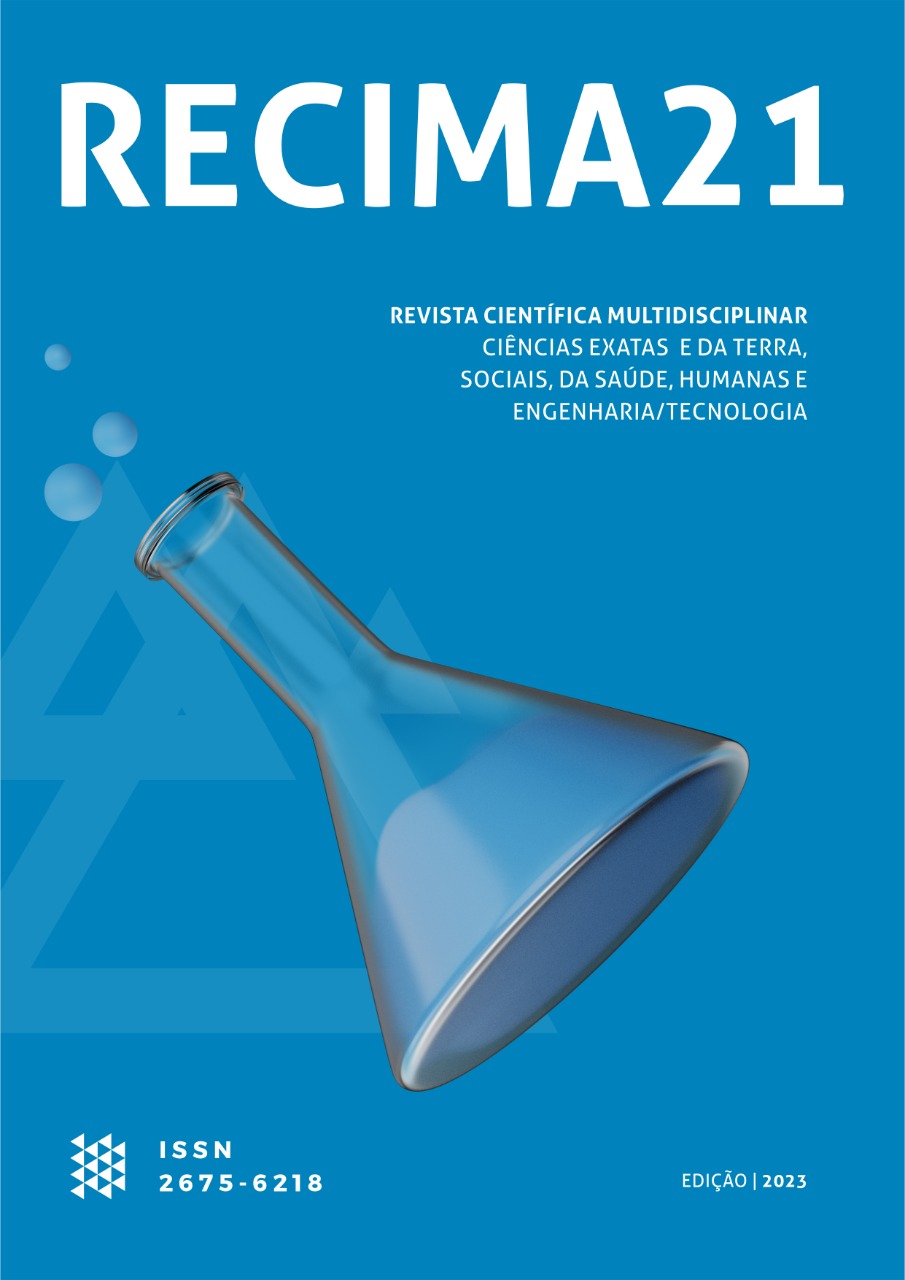NEURO VISUAL HEALTH AND LEARNING
DOI:
https://doi.org/10.47820/recima21.v4i1.2620Keywords:
visual neuro system acts directly or indirectly to the receptionAbstract
The visual neuro system acts directly or indirectly to the reception of learning, thus exerts influence on the efficiency of processing and visual health, as a consequence of learning. The visual pathways run through several lobes between the input of light and somatosensory processing. Environmental changes, the use of screens in a continuous way, changes in eating and social habits, produce disastrous changes in the neuro visual processing system. Any disorder can trigger difficulties in learning. Personalized and individualized evaluation is critical to ensuring the best vistive performance. The primary visual care service has great responsibility in this evaluation process, and in much of the world optometry is attributed. The visual and learning processes, their disorders and the evaluative role for learning is approached through the review of publications.
Downloads
References
ACOSTA, M. et al.. Student acceptance of e-learning methods in the laboratory class in Optometry. PLOS One. December 13, 2018. DOI 10.1371/journal.pone.0209004
AZEVEDO, C. et al., Influência dos sintomas visuais no desempenho escolar de adolescentes. Rev Bras Oftalmol. 2019; 78 (4): 246-9.DOI 10.5935/0034-7280.20190137. Acesso:01/12/2022.
BAKAR, N., HONG, C., GOH, P. COVD-QOL questionnaire: An adaptation for school vision screening using Rasch analysis. Journal of Optometry 5(4):182–187. Oct 2012. 10.1016/j.optom.2012.05.004 Acesso 02/12/2022
BALBANI, A.; KRAWCZYK, A. Impacto do uso do telefone celular na saúde de crianças e adolescentes. Rev Paul Pediatr 2011;29(3):430-6. DOI 10.1590/S0103-05822011000300019. Acesso: 02/12/2022
BEAR, M., CONNORS, B., PARADISO, M. Neurociências: Desvendando o sistema nervoso. 3ª. Porto Alegre: Artmed, 2008
CAPELLINI, S. et al. Phonological awareness, working memory, reading and writin performances in familial dyslexia. Pró-Fono Revista de Atualização Científica. 2007 out-dez;19(4). Disponível: <https://www.scielo.br/j/pfono/a/tdxtMTsTp8CRfjtNfKCG73g/?format=pdf&lang=en> Acesso 01/12/2022
FERNANDES, C. et al. Possibilidades de aprendizagem: reflexões sobre neurociência do aprendizado, motricidade e dificuldades de aprendizagem em cálculo em escolares entre sete e 12 anos. Ciênc. educ. (Bauru) 21 (2) Apr-Jun 2015 DOI 10.1590/1516-731320150020009. Acesso 01/12/2022.
LENT, R. Cem bilhões de neurônios: conceitos fundamentais da neurociência. São Paulo: Atheneu, 2001.
ANDEL, E. et al. Princípios da neurociências. 5a. Porto Alegre: Artmed,2014.
MORAES, F.; MALUF, M. PsicoMotricidade no contexto da neuroaPrendizageM: contribuições à ação PsicoPedagógica. Rev. Psicopedagogia 2015; 32(97): 84-92. Disponível: em <https://cdn.publisher.gn1.link/revistapsicopedagogia.com.br/pdf/v32n97a09.pdf> Acesso 30/11/2022.
NUNES, A. et al. Desempenho visual: validação do inventário de eficiência visual em estudantes. Rev. bras. oftalmol. 74 (2) Mar-Apr 2015. Https://doi.org/10.5935/0034-7280.20150021 Acesso 1/12/22
NUNES, F.; et al. Asthenopic symptoms prevalence in undergraduate students. Rev Bras Oftalmol. 2018; 77 (6): 334-7. DOI 10.5935/0034-7280.20180072. Acesso: 01/12/2022
PASSOS, A.; SONODA, R. GAMIFICAÇÃO PARA TRATAMENTO DE DISTÚRBIOS VISUAIS, O VILÃO SE TORNA HERÓI . RECIMA21 - Revista Científica Multidisciplinar v. 3, n. 11, p. e3112148, 2022. DOI: 10.47820/recima21.v3i11.2148. Acesso em: 6 dez. 2022.
PILLING, R. et al. Referral thresholds for an integrated learning disability eye care pathway: a consensus approach. Spring Natures. Eye (2022) 36:742–748. Nov 2021. https://doi.org/10.1038/s41433-021-01516-y. Acesso 01/12/2022
ROSALES, F. A luz azul nociva em crianças. In SONODA, R. Optologia III: Aprendizagem. Florianopolis: C. Autores, 2021.
SOARES, I. C. Quality of life related to visual health and fatigue of people with visual processing disorders. 2021. 93p. Thesis (Doctorate in Health Care) - Federal University of Triângulo Mineiro, Uberaba (MG), 2021.
SONODA, R; ARAUJO, A. (2022a). DISTÚRBIOS NEUROVISUAIS CAUSADOS POR LUZ AZUL. RECIMA21 - Revista Científica Multidisciplinar - ISSN 2675-6218, 3(3), e331247. DOI 10.47820/recima21.v3i3.1247 Acesso: 02/12/2022.
SONODA, R. ; DA SILVA, F. HIGIENE VISUAL: ALTERAÇÕES OCULARES, MOTORAS E A APRENDIZAGEM. RECIMA21 - Revista Científica Multidisciplinar v. 2, n. 9 (2021) DOI: 10.47820/recima21.v2i9.710. Acesso em: 6 dez. 2022.
SONODA, R. Desenvolvimento escolar e a visão. Pesquisas Em Temas De Ciências Da Educação, V3. Belém: RFB, 2021.
VASCONCELOS, P.; OLIVEIRA, K.; SONODA, R.A INSUFICIÊNCIA DE CONVERGÊNCIA. RECIMA21 - Revista Científica Multidisciplinar. v. 3, n. 11, p. e3112236, 2022. DOI: 10.47820/recima21.v3i11.2236. Acesso em: 6 dez. 2022.
VILHENA, D. Déficit magnocelular e estresse visual associados a dificuldade de leitura. (2021) - Tese doutoramento Faculdade de filosofia e ciências humanas - Universidade Federal de Minas Gerais. Disponível em: https://repositorio.ufmg.br/bitstream/1843/45427/4/Vilhena_Tese_de_Doutorado_Defesa_vers%C3%A3o_final_07-07-2021.pdf Acesso: 01/12/2022
Downloads
Published
How to Cite
Issue
Section
Categories
License
Copyright (c) 2023 RECIMA21 - Revista Científica Multidisciplinar - ISSN 2675-6218

This work is licensed under a Creative Commons Attribution 4.0 International License.
Os direitos autorais dos artigos/resenhas/TCCs publicados pertecem à revista RECIMA21, e seguem o padrão Creative Commons (CC BY 4.0), permitindo a cópia ou reprodução, desde que cite a fonte e respeite os direitos dos autores e contenham menção aos mesmos nos créditos. Toda e qualquer obra publicada na revista, seu conteúdo é de responsabilidade dos autores, cabendo a RECIMA21 apenas ser o veículo de divulgação, seguindo os padrões nacionais e internacionais de publicação.

 Clique para ver detalhes
Clique para ver detalhes 











